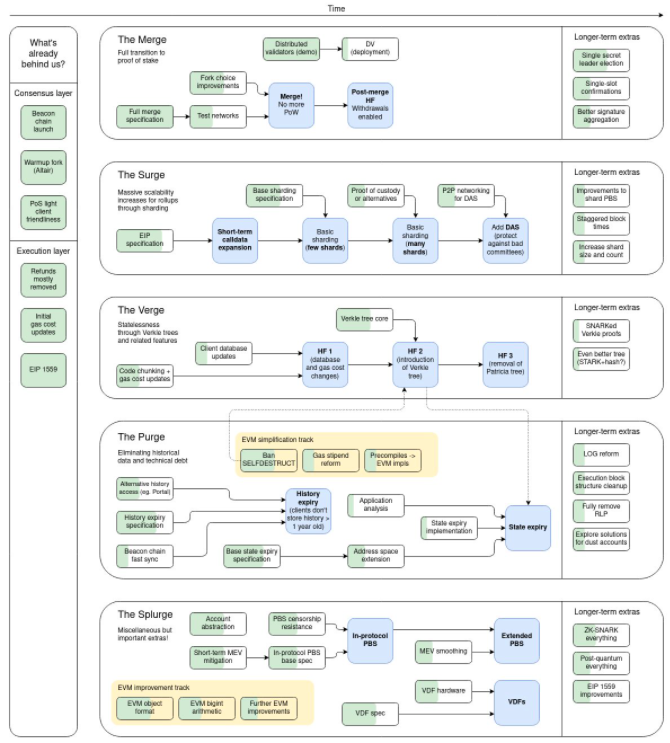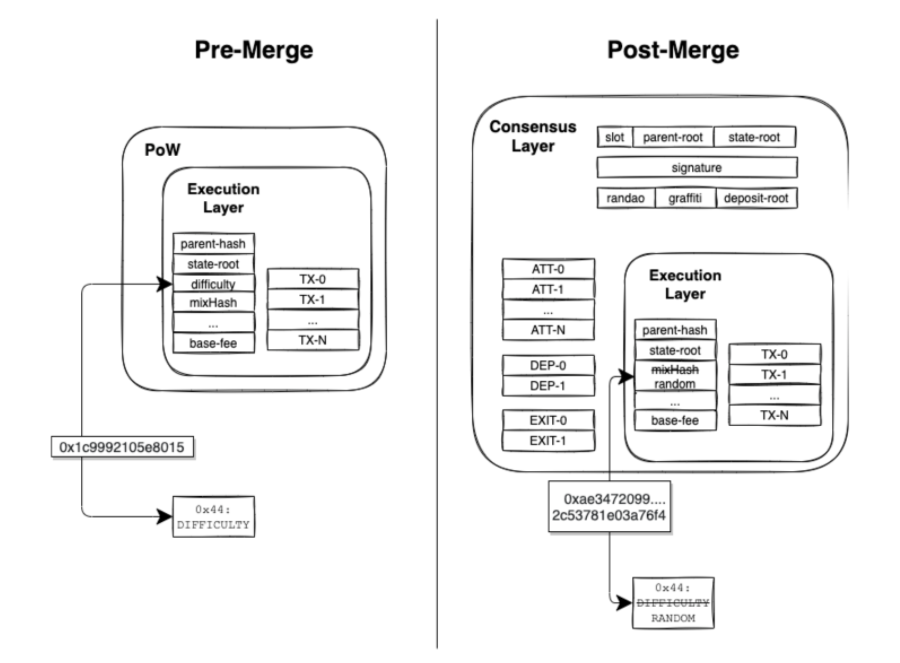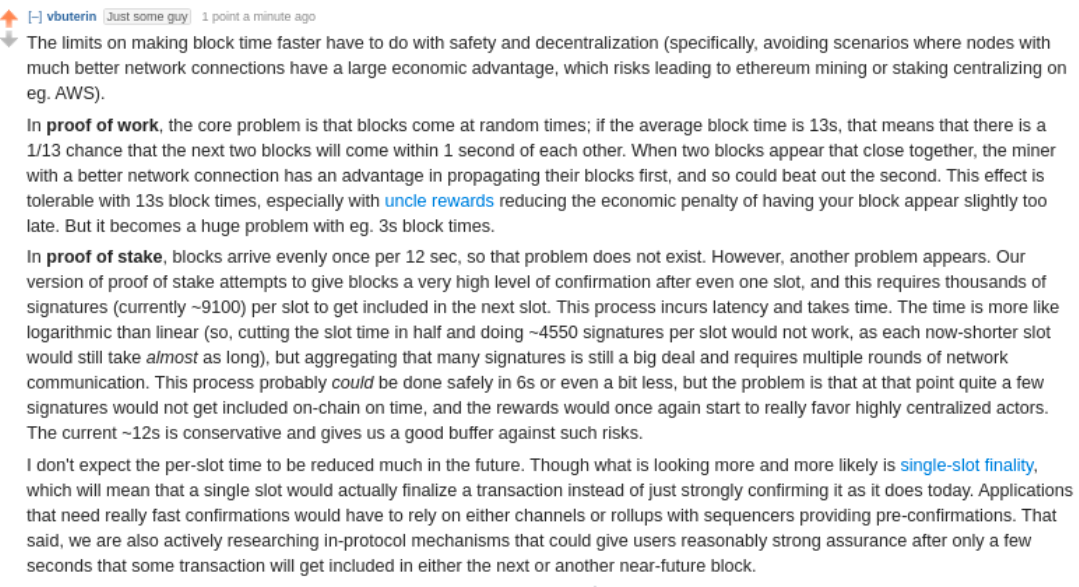Ethereum Mainnet will merge with The Beacon Chain to upgrade Ethereum’s current proof-of-work consensus mechanism (PoW; mining) with proof-of-stake (PoS; staking). It’s designed to have minimal impact on how Ethereum operates for end-users, smart contracts, and decentralized applications (Bieko 2021). The Merge is expected to take place in Q2 2022— likely May or June. The Ethereum community is gassed up; this tentative deadline instills some positive expectations. But knowing Ethereum, and knowing development in general, we can only be anxiously optimistic. Ethereum evangelists have displayed tremendous patience over the last several years. We’ve been hearing ETH 2.0 chatter for what seems like a lifetime. Let’s review what The Merge entails. In our opinion, the Merge kickstarts Phase 1 - Shard Chains, in the ETH 2.0 roadmap.

The Beacon Chain (Phase 0) shipped on December 1, 2020. It introduced proof-of-stake to Ethereum and set Ethereum up for shard chains. Ethereum.org calls it a “new way to keep Ethereum secure, like a public good that makes Ethereum healthier and earns users more ETH in the process. One stakes ETH to activate the validator software and, in doing so, processes transactions and creates new blocks in the chain.” Note: the Beacon Chain exists separately from Ethereum Mainnet—that’s why it’s called the Merge. The Beacon Chain is already running, preserving the history of the network and its functionality but crucially changing the consensus mechanism (Nelson, 2021). Once this merge occurs, Sharding (Phase 1) begins. “Shard chains are the key to Ethereum’s future scalability as they allow parallel transaction throughput. There will be 64 of them deployed in Phase 1 (with the possibility of adding more over time as hardware scales). Phase 1 is primarily concerned with the construction, validity, and consensus on the data of these shard chains. Phase 1 does not specify shard chain state execution or account balances. It’ll be like a trial run for the sharding structure rather than an attempt to use shards to scale. The Beacon Chain will treat shard chain blocks as simple collections of bits with no structure or meaning” (ethhub.io).

Back in October, Tim Beiko, Ethereum Foundation community manager stated “We think ~4 months is a generous timeframe from having the code done to seeing the merge on mainnet. We think there’s a chance that the code being done can happen by February (obviously, still a lot of unknowns!), so we decided to set the difficulty bomb based on that.” In this statement, Bieko is talking about the difficulty bomb which will make Ethereum impossible to mine on its new chain (Layram, 2022). Note that the difficulty bomb has already been delayed and the merge has been pushed out. Earlier this week, Bankless published an article stating the Merge will now take place in 3 months (June) for the following reasons:
- “There’s a planned ‘difficulty bomb’ coming mid-June.
- Danny Ryan signaled that a delay in the bomb isn’t needed.
- The Merge Mainnet Readiness Checklist is nearing completion.
- Devs are being picky about delays.
- The Kiln testnet is testing the merge.”
Bankless calls the Merge “the most significant blockchain network upgrade ever, and probably ever will be.” Moreover, “if Ethereum achieves its goals of becoming the global settlement layer for the metaverse, it would elevate the merge to one of the most historically significant events of the modern age.” Those are bullish comments. Bankless is excited for post-merge Ethereum for the following reasons (highlighted originally by SuperPhiz):
- “There is ~10.5M ETH staked in the Beacon chain now, earning 4.8% ETH-denominated yield (which is quality returns).
- Post-merge, staking yields jump to ~10-15% with new ETH issuance reduced by 90% (the famous Triple Halvening).
- PoW miners earn 12k ETH per day and need to sell; PoS validators earn 1.280 ETH with no reason to sell.”
Many agree that a critical component of a successful merge is safety and thorough testing. This is akin to any software and testnets exist. On Tuesday, March 15, a bug was found in the Kiln testnet block proposal. Kiln, a successor to Kintsugi, is likely the last merge testnet created before existing public testnets are upgraded. The Prysm client had a bug.
“Prysm beacon node used incorrect endianness to marshal/unmarshal the base_fee_per_gas field in the execution_payload object. Today, the execution layer uses big endianness, and the consensus layer uses little endianness. Since Prysm incorrectly unmarshals execution_payload back to the original form, the execution layer client correctly rejected the deformed payload when calling engine_newpayloadv1 endpoint by returning INVALID_BLOCK_HASH. (https://hackmd.io/@prysmaticlabs/HyZqgTA-c)"
Implementation risk has always been somewhat of an issue for ETH 2.0. Thankfully, testnets are there to safeguard for mainnet launches. Ethereum devs feel they need to spend the next several weeks improving the testnet infrastructure, finding issues, and growing confidence in new implementations. If they don’t feel comfortable with the state of testnets, they may need to push back the difficulty bomb. The more iterations of testnet the better. It’s tough work. Kudos to the devs out there. 👏🏽
The evolution to ETH 2.0 is deemed a necessary change for the following reasons:
- Increased sustainability due to the decreased environmental impact
- Improved scalability due to the increased number of transactions
- Improved security due to the decreased likelihood of a 51% attack
Why is the Merge important now? “Architecturally, the Merge is making use of the existing technology in Ethereum and supplementing it with what we need for the future. Current Ethereum clients, like Hyperledger Besu, will become known as ‘execution clients’ and will handle state storage, block production, and smart contract interactions. ‘Consensus clients,’ like Teku, will handle synchronizing state across the network and submitting transactions to the beacon chain. A new piece of technology called the ‘engine API’ will allow these two clients to talk to each other extremely efficiently. Altogether, this new stack powers PoS with existing technologies and formats (like JSON RPC) and new ones such as REST APIs for the consensus clients” (Nelson, 2021).
The Merge signifies a more scalable, sustainable, and secure Ethereum. It’s evidently around the corner and excites the community beyond belief. Since the London upgrade and EIP 1559, Vitalek has said there’s proof the Ethereum ecosystem can make significant changes; he’s more confident about the Merge (Martin, 2021). The network’s energy consumption is supposed to fall by 99%. This narrative speaks extraordinarily well with current macro-political-economic narratives. Global energy consumption is under fire. Let’s embrace decentralized open-source technology and see where the Ethereum rocket lands.

Sources:
HackMD (March 2022). Kiln testnet block proposal failure https://hackmd.io/@prysmaticlabs/HyZqgTA-c
Hoffman, D. (March 2022). Don't sleep on the merge [LITE] https://newsletter.banklesshq.com/p/dont-sleep-on-the-merge-lite?s=r
Ruby Layram (March 2022). Ethereum Merge Set To Happen By June 2022 https://www.banklesstimes.com/news/2021/10/18/ethereum-merge-set-to-happen-by-june-2022/ Ethhub.io
Ethereum Foundation Blog (March 2022). Announcing the Kiln Merge Testnet https://blog.ethereum.org/2022/03/14/kiln-merge-testnet/
EthHub (2022). Ethereum 2.0 Phases https://docs.ethhub.io/ethereum-roadmap/ethereum-2.0/eth-2.0-phases/
Tim Beiko, (November 2021). How The Merge Impacts Ethereum’s Application Layer. https://blog.ethereum.org/2021/11/29/how-the-merge-impacts-app-layer/
Matt Nelson, (December 2021). The State of the Merge: An Update on Ethereum’s Merge to Proof of Stake in 2022. https://consensys.net/blog/news/the-state-of-the-merge-an-update-on-ethereums-merge-to-proof-of-stake-in-2022/
Martin Young, (August 2021). Vitalik: ‘More confident about the merge’ following Ethereum’s successful London upgrade. https://cointelegraph.com/news/vitalik-more-confident-about-the-merge-following-eth-s-successful-london-upgrade
Vitalik Buterin (February 2022). A quick post explaining the current choice of block times (both pre- and post-merge) and the tradeoff between speed and decentralization/safety.https://twitter.com/VitalikButerin/status/1490391141677633537/photo/1
Vitalik Buterin (December 2021). Happy birthday beacon chain! Here's an updated roadmap diagram for where Ethereum protocol development is at and what's coming in what order. (I'm sure this is missing a lot, as all diagrams are, but it covers a lot of the important stuff!). https://twitter.com/VitalikButerin/status/1466411377107558402/photo/1 Blog.Ethereum.org (March 2022). https://blog.ethereum.org/2022/03/14/kiln-merge-testnet/